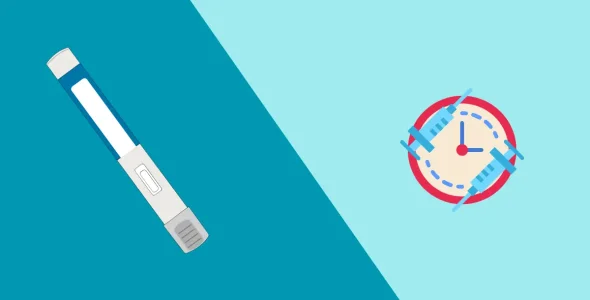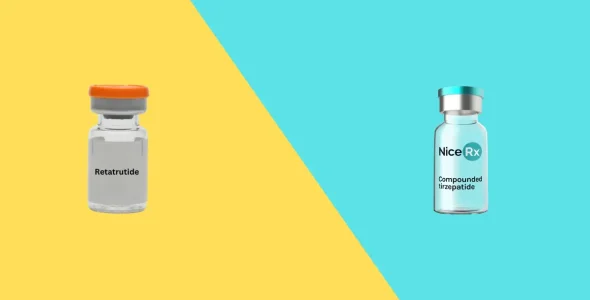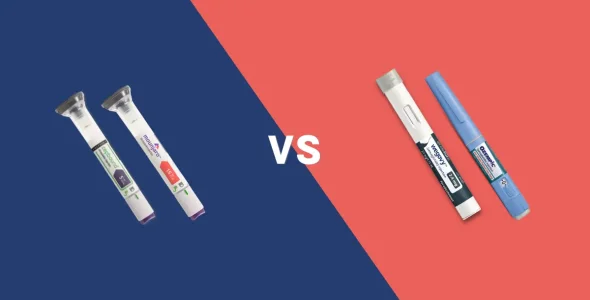Microdosing tirzepatide chart: A complete guide to benefits, dosage and safety
Tirzepatide is changing the game for weight loss and metabolic health—but what if you could get the benefits with fewer side effects? Discover how microdosing unlocks a safer, more sustainable approach.
Key highlights
- Microdosing tirzepatide involves using sub-therapeutic or lower doses than standard doses to get slow and gradual benefits with minimal side effects.
- Microdosing is beneficial for those who want to achieve slower weight loss or glycemic control, along with potential metabolic benefits. It is an off-label practice.
- There is currently no safety or efficacy data on microdosing, as no clinical trials have been conducted yet to test its effectiveness and long-term safety.
- Consult an authorized healthcare provider before starting tirzepatide microdosing to get a personalized titration schedule. Seek medical guidance if you experience any side effects.
Tirzepatide, a dual GIP/GLP-1 agonist, is available under two brand names: Mounjaro and Zepbound. The medication occupies both receptors simultaneously to suppress appetite and regulate blood glucose levels. Primarily, Mounjaro is used for blood sugar control in type 2 diabetes patients, while Zepbound is FDA-approved for promoting weight loss and weight-related complications like moderate to severe obstructive sleep apnea.
Microdosing is an off-label practice that involves using sub-therapeutic doses of medications for gradual benefits with fewer side effects. Microdosing tirzepatide is getting popular these days, especially due to viral trends on social media, and many patients are using this practice to reduce the risk of adverse events, lower costs, and lose weight more slowly and gradually, instead of drastic weight loss that can lead to negative changes in physical appearance.
This article provides a balanced perspective on microdosing tirzepatide, including potential benefits, significant risks, and essential considerations.
Although microdosing tirzepatide has gained significant attention, it is not approved by the FDA. It should be done under medical supervision after seeking medical advice from a licensed healthcare provider.
What is tirzepatide, and how does it work?
Tirzepatide is a dual agonist at GIP and GLP-1 receptors. The medication simultaneously binds GIP (glucose-dependent insulinotropic peptide) and GLP-1 (glucagon-like peptide-1) receptors and activates them. GLP-1 is a natural hormone that regulates appetite and calorie intake after you eat food. By targeting these receptors, tirzepatide suppresses appetite and delays stomach emptying, which reduces food intake.
Lower calorie intake and slow digestion of food lower blood sugar levels, promote weight loss, and maintain weight reduction. Weight management also helps relieve obstructive sleep apnea.
Brand-name medications Mounjaro and Zepbound are approved by the FDA for different indications. Mounjaro is FDA-approved for promoting glycemic control or blood sugar control in adult patients who have type 2 diabetes. The medication cannot be used for type 1 diabetes patients. The medication is used off-label for weight management.
Zepbound is primarily approved for weight reduction in adults with:
- Obesity: BMI 30 kg/m² or more
- Overweight: BMI 27 kg/m² or more plus at least one weight-related condition (e.g., hypertension (high blood pressure), type 2 diabetes, high cholesterol levels, or sleep apnea)
- Moderate to severe obstructive sleep apnea
What is tirzepatide microdosing?
Microdosing GLP-1 medications involves administering sub-therapeutic or fractional doses instead of standard doses or extending the time interval between doses. For example, the lowest standard dose of tirzepatide is 2.5 mg per week. For microdosing, your healthcare provider may recommend 1.5 mg or 1.8 mg weekly, which is lower than the standard dose. Additionally, taking 2.5 mg every 10 or 15 days instead of once weekly is another form of microdosing.
During tirzepatide microdosing, your doctor may extend the titration period. Generally, tirzepatide dosage is escalated every 4 weeks. For microdosing, they may increase the dosage after 8-10 weeks.
Why are people microdosing tirzepatide?
Patients are microdosing tirzepatide due to the following reasons:
Side effect mitigation
GLP-1 medications like tirzepatide have various side effects, including nausea, diarrhea, vomiting, abdominal discomfort, and bloating. Microdoses are used off-label to mitigate these side effects.
Cost concerns
The list prices for Mounjaro and Zepbound are $1,079.77 and $1,086.37 per month, respectively. From local pharmacies, patients usually purchase these medications for $1,000-1,300 without insurance. Microdosing helps reduce the cost of these medications as this practice extends the time of Mounjaro and Zepbound usage.
Seeking subtle and sustained benefits
Mounjaro promotes significant blood sugar control, and Zepbound reduces body weight. Sometimes, these changes are rapid and more dramatic with standard dosing. They trigger stress, anxiety, and inflammation in the body. Moreover, quick weight changes can act as a stressor and may induce telogen effluvium (loss of hair). Microdosing may help tackle all these problems as it involves smaller doses that bring subtle and sustainable results instead of rapid changes.
Personalized approach
Not every patient has a good tolerance to medications. Some patients are sensitive to even low doses of tirzepatide. Microdosing allows them to test their bodies with the lowest doses and see how the body reacts. This practice also helps them prevent intolerable side effects, as lower doses tend to have fewer adverse effects.
Benefits of microdosing tirzepatide
Let’s explore the potential benefits of microdosing tirzepatide.
Lower incidence of side effects and improved tolerability
In clinical trials, 78.9% to 81.8% of patients using tirzepatide experienced side effects compared to 72% of participants in the placebo group. Common side effects were nausea, constipation, diarrhea, fatigue, bloating, abdominal pain, and gastrointestinal problems. Serious adverse events were gastroparesis, gallbladder problems, pancreatitis, and biliary diseases. Generally, these side effects are severe when you start the medication or worsen with a dose increment, but they subside over time. The incidence of these side effects increased with higher doses.
Microdosing is used off-label to reduce the incidence of these side effects and improve the body’s tolerance. Lower and fractional doses allow the body to adjust slowly and gradually, leading to better adherence. Moreover, your doctor may increase the tirzepatide dosage more slowly during microdosing compared to standard time intervals (4 weeks), which also minimizes the risk of adverse effects.
Gradual and sustainable weight loss
Tirzepatide has the potential to reduce body weight by 15-20%. Rapid weight loss can lead to various side effects, like fatigue, gastrointestinal problems, hair loss, changes in facial appearance, visible signs of premature aging, digestive issues, reduced muscle mass and bone density, and mental health issues such as depression and anxiety. These changes can also cause skin sagging, wrinkling, and volume loss.
Microdosing promotes weight loss more slowly, along with long-term lifestyle changes. Gradual weight changes do not significantly affect your body or change your facial appearance.
Improved glucose control
As tirzepatide has a glucose-lowering effect, patients may experience blood sugar drops while taking the medication for diabetes management or weight loss. Microdosing tirzepatide helps improve blood sugar control without frequent blood sugar drops. Remember, this is helpful for prediabetics or those who have slightly high blood sugar levels. If you have uncontrolled diabetes, do not try microdosing and follow standard FDA recommendations regarding tirzepatide dosing.
Metabolic optimization
Tirzepatide has various metabolic benefits. The medication improves insulin sensitivity, reduces cardiovascular risks, preserves kidney function, improves gut function, and has neuroprotective and anti-inflammatory effects.
You may get these benefits even at low doses. However, the studies on the metabolic benefits of microdosing tirzepatide are still limited.
- Clinical studies show that tirzepatide reduced 5% to 20.9% of body weight after 72 weeks and improved insulin sensitivity by affecting weight-dependent and weight-independent mechanisms. In another clinical trial, tirzepatide reduced fasting blood glucose levels by 43.6 mg/dL to 74.4mg/dL in patients with type 2 diabetes.
- A press release by the American College of Cardiology states that tirzepatide reduced the risk of death from heart and blood vessel-related diseases or heart failure by 38% as compared to placebo, after one year.
- In the SURPASS-4 trial, 15 mg weekly tirzepatide reduced the levels of total cholesterol, LDL cholesterol, and triglycerides by 5.6%, 7.9%, and 22.5%, respectively, and increased the levels of good cholesterol -HDL by 10.8% compared to placebo.
- In the SUMMIT clinical trial, tirzepatide significantly improved kidney function by improving glomerular function and reducing proteinuria. The trial shows that tirzepatide increases glomerular filtration rate (eGFR) when used for a longer time.
- Tirzepatide has neuroprotective effects. Research studies show that the medication reduces the risk of dementia in patients with type 2 diabetes, prevents neurodegeneration, and improves cognitive functions.
- GLP-1 medications like tirzepatide have anti-inflammatory effects. They suppress inflammation and inhibit the formation of reactive oxygen species (ROS). Additionally, they inhibit the function of macrophages in the blood vessels and production of pro-inflammatory cytokines such as IL-6, IL-1β, TNF-α, and C-reactive protein (CRP).
- Additionally, GLP-1 medications are also helpful in managing certain gastrointestinal diseases such as celiac disease, inflammatory bowel diseases (IBD), including Crohn’s disease and ulcerative colitis (UC), and intestinal mucositis. In the gastrointestinal tract, they improve the integrity of the gastrointestinal mucosa and reduce inflammation.
Remember, these results are based on standard doses of tirzepatide. Studies on the metabolic benefits of microdosing tirzepatide have not been conducted yet.
Cost-effectiveness and accessibility
Zepbound and Mounjaro are expensive medications for cash-paying patients who do not have insurance. Some insurance companies do not cover weight loss medications as they do not consider them a medical necessity. In such cases, purchasing tirzepatide is unaffordable for many patients. Microdosing extends the supply of tirzepatide as it divides standard doses into multiple doses. This practice also makes these medications more accessible during drug shortages by extending the time intervals of using the standard dose.
Behavioral and lifestyle alignment
Tirzepatide is used in combination with lifestyle modifications. These include increased exercise and a low-calorie and low-fat diet. When you start the medication, changing your lifestyle suddenly might be difficult. Microdosing helps adapt these habits slowly and gradually by improving satiety and suppressing appetite.
Microdosing may also reduce your cravings for fatty, spicy, salty, or high-calorie foods and prevent hedonic eating.
Microdosing tirzepatide schedule: How to microdose tirzepatide
As microdosing is an experimental and off-label practice, currently, there is no data or recommendations on tirzepatide dosage. The following are a few hypothetical examples for information purposes only.
Craig Koniver, MD, a physician from South Carolina, suggests that microdoses of tirzepatide can be 60% of the lowest standard dose for women, 72% of the lowest dose for men, for weight loss. The goal of this dosing plan is to lose 2 pounds or less per week. The titration schedule can be as follows (for example):
Month 1:
- Women: 1.5 mg once weekly
- Men: 1.8 mg once weekly
(Note: The standard starting dose is 2.5 mg weekly; microdosing begins at lower doses of 1.5 mg for women and 1.8 mg for men.)
Month 2:
- Women: 3 mg once weekly (instead of the standard 5 mg)
- Men: 3.6 mg once weekly (instead of the standard 5 mg)
Month 3:
- Women: 4.5 mg once weekly (instead of the standard 7.5 mg)
- Men: 5.4 mg once weekly (instead of the standard 7.5 mg)
Afterwards, you can gradually increase tirzepatide doses while remaining below the standard dosing increments.
Common hypothetical tirzepatide microdosing schedules
| Month | Women (mg/week) | Men (mg/week) | Standard Dose Comparison |
|---|---|---|---|
| Month 1 | 1.5 | 1.8 | Starting dose: 2.5 mg |
| Month 2 | 3 | 3.6 | Instead of 5 mg |
| Month 3 | 4.5 | 5.4 | Instead of 7.5 mg |
| Month 4+ | Gradual increases | Gradual increases | Below standard increments |
Strategy A: Smaller incremental doses (using compounded pharmacy)
Since the brand-name pens are single-use and pre-measured (2.5mg, 5mg, 7.5 mg, 10 mg, 12.5 mg, and 15 mg), a microdosing schedule often requires a prescription for a compounded version of tirzepatide from a licensed compounding pharmacy, which can create custom doses.
Example of a microdosing schedule:
- Weeks 1-4: 1.0 mg once weekly
- Weeks 5-8: 1.5 mg once weekly
- Weeks 9-12: 2.0 mg once weekly
- Week 13+: Transition to the standard 2.5 mg dose, then follow the standard escalation schedule.
Tirzepatide microdosing: Smaller incremental doses
| Strategy A: Smaller Incremental Doses (Compounded Pharmacy) | Column 1 |
|---|---|
| Weeks | Dose (mg) - Once Weekly |
| Weeks 1-4 | 1.0 mg |
| Weeks 5-8 | 1.5 mg |
| Weeks 9-12 | 2.0 mg |
| Week 13 and beyond | Transition to 2.5 mg (standard dose), then follow standard escalation |
Strategy B: Increased frequency with smaller doses
This involves administering a very small dose more frequently than once a week (for example, every 3-4 days) to keep drug levels more stable and avoid the sharp “peak” that can cause side effects.
Example schedule:
- Dose: 0.5 mg
- Frequency: Every 3 days (for example, Monday morning and Thursday evening).
This provides a total weekly dose of approximately 1.0 mg; spreading it out potentially improves tolerance.
Tirzepatide vs. other GLP-1 agonists
Tirzepatide is more effective than other GLP-1 medications (GLP-1 receptor agonists) such as semaglutide (Wegovy, Ozempic, and Rybelsus), dulaglutide, and liraglutide.
A clinical study compared the efficacy of 1 mg semaglutide (Ozempic) with tirzepatide (Mounjaro) at varying doses of 5 mg, 10 mg, and 15 mg. At the start of the trial, participants had an average HbA1c level of 8.28%. After 40 weeks of treatment, tirzepatide demonstrated significant reductions in HbA1c: -2.01% at 5 mg, -2.24% at 10 mg, and -2.30% at 15 mg. In contrast, the 1 mg dose of semaglutide lowered HbA1c by -1.86%. Additionally, tirzepatide was linked to more pronounced weight loss compared to semaglutide.
Another clinical trial with 636 participants was conducted over 52 weeks to compare the effects of tirzepatide and dulaglutide. Patients taking 15 mg of tirzepatide experienced a significant reduction in HbA1c levels by 2.8%, whereas those on 0.75 mg of dulaglutide experienced a smaller decrease of 1.3%. Regarding weight loss, individuals treated with tirzepatide lost an average of 10.7 kg, while the dulaglutide group lost only about 0.5 kg.
Risks and considerations for microdosing tirzepatide
The following are risks and considerations for microdosing tirzepatide:
Lack of clinical evidence and FDA approval
Currently, microdosing tirzepatide is not recommended or approved by the FDA for managing weight or blood sugar levels. This is largely because no large-scale clinical trials have rigorously evaluated the safety or effectiveness of using sub-therapeutic doses of this medication. As a result, scientific data to support microdosing protocols is scarce.
Although some individuals may report positive effects anecdotally, these personal accounts do not replace medical evidence. Currently, there is no clinical research confirming that microdoses of tirzepatide can cause weight loss, improve glycemic control, or enhance metabolic health.
As microdosing involves taking doses far below the standard therapeutic range, you may experience minimal or no noticeable benefits. The potential outcomes mainly depend on your body’s physiology and how your body responds to the glucose-lowering effect of tirzepatide.
Although microdosing semaglutide may reduce side effects due to lower initial doses, it may not be effective enough to produce significant clinical results.
Reduced efficacy concerns
Tirzepatide is primarily prescribed to help manage blood glucose levels in individuals with type 2 diabetes and reduce body weight. The medication typically shows a significant reduction in blood sugar levels and improves glycemic control when you use the medication at FDA-approved therapeutic doses (such as 2.5 mg, 5 mg, 10 mg, 12.5 mg, and 15 mg).
However, if you choose to use sub-therapeutic or microdoses (doses well below the clinical threshold, such as 0.05 mg or 0.5 mg), the effectiveness of tirzepatide may not be the same. Lower doses of tirzepatide may not trigger the intended metabolic or glucose-lowering effects. As a result, you may not achieve adequate blood sugar regulation.
Zepbound promotes weight loss (typically reduces 15-20% of body weight) at standard doses. Several clinical trials have proven the efficacy of tirzepatide for weight management by suppressing appetite, improving insulin sensitivity, and reducing body fat.
However, the weight loss effects may be less noticeable if you use sub-therapeutic doses for microdosing, as the body does not receive a strong enough dose to activate the full therapeutic mechanisms. You may experience mild or even negligible weight reduction.
Challenges with the administration
Tirzepatide is typically dispensed in pre-filled pens with fixed, standardized doses, which are convenient to use and have accurate dosage measurements. However, using these pens to administer fractional or microdoses can be confusing for patients. Many patients struggle to determine how many “clicks” they need to count to inject a specific microdose. This increases the risk of under- or overdosing.
Some compounding pharmacies offer tirzepatide in microdose formulations to meet the growing demand for microdoses. They typically offer compounded tirzepatide in multidose vials. Although compounded tirzepatide may offer dosing flexibility, it may have certain safety concerns.
Additionally, compounded drugs carry a higher risk of contamination, especially if the compounding pharmacy does not adhere to strict quality standards. Always ensure that your compounded tirzepatide is sourced from a state-licensed or FDA-registered compounding facility to reduce the risk of receiving a substandard or unsafe medication.
Many patients use syringes and multidose vials to administer microdoses of tirzepatide. This method is also linked to certain risks. Patients may not follow proper hygiene and injection protocols, which increases the risk of skin infections and blood-borne diseases. Reusing syringes or sharing needles can also spread infections.
Follow these measures to minimize infection risks:
- Always use a new, sterile syringe for each injection.
- Never share injection devices with others.
- Disinfect the vial top and injection site properly before use.
- Store your supplies in a clean and dry place.
Patients may also overlook storage guidelines for tirzepatide. Pre-filled tirzepatide pens typically remain effective for up to 8 weeks after opening, if they are kept in a refrigerator. In contrast, compounded tirzepatide usually has a shorter shelf life (30 to 45 days). Microdosing can stretch the use of a single vial over weeks, and if patients are unaware of expiration timelines, they may unknowingly inject expired medication. Injecting expired or improperly stored medication may be less effective and unsafe.
Importance of medical supervision
If you plan to start microdosing with tirzepatide, first consult a healthcare provider who has experience with GLP-1 medications. Microdosing is not appropriate or safe for everyone, particularly when you have poorly controlled diabetes or other significant health issues.
Microdosing tirzepatide involves complex dosing schedules. It is suitable for those patients who are capable of carefully following these instructions to avoid dosing errors.
Once you begin treatment, maintain regular communication with your healthcare provider. They will guide you on dose adjustments, monitor any side effects, and help manage potential risks associated with treatment. It is essential to monitor your blood glucose readings, weight fluctuations, and any associated symptoms or side effects. Discuss these side effects or blood sugar fluctuations during your follow-up appointments so your healthcare provider can make necessary dosage adjustments accordingly.
Potential for unknown long-term side effects
Currently, there is limited evidence regarding the long-term safety and effectiveness of microdosing protocols for tirzepatide. Like standard dosing, microdosing may also carry risks of long-term side effects, but these have not been thoroughly studied or well-documented.
Further clinical research is necessary to fully understand the potential benefits and risks associated with prolonged microdosing of tirzepatide. The long-term side effects of tirzepatide are still not well-known.
It is also important to note that you may regain the weight loss during microdosing when you discontinue the medication, like with standard or regular doses. You will need to stick to lifestyle changes to prevent weight gain.
Potential side effects and how to manage them
Although microdosing semaglutide typically involves lower quantities than standard doses, the side effects are similar. Common side effects may include:
- Mild to moderate nausea
- Occasional vomiting
Constipation or irregular bowel movements - Diarrhea
- General abdominal discomfort or stomach pain
- Excessive burping and bloating
In addition to these, some users have reported more serious or rare adverse reactions, such as:
- Pancreatitis (inflammation of the pancreas)
- Gallbladder-related issues, including gallstones
- Acute kidney injury in sensitive individuals
- “Ozempic face” (facial volume loss or sagging)
- Allergic reactions (rash, itching, or swelling)
- Changes in mood or behavior, including signs of depression
- Suicidal thoughts or ideation (seek immediate medical help if experienced)
- Higher risk of aspiration during procedures involving sedation or anesthesia
- Increased risk of thyroid tumors, such as medullary thyroid carcinoma (MTC) has been observed in rodent studies.
- Endocrine disorders such as MEN 2 (Multiple Endocrine Neoplasia type 2 syndrome)
Due to the potential risk for thyroid cancer, you should not use tirzepatide if you have a personal or family history of MTC or MEN 2 syndrome. Additionally, this medication is not recommended for pregnant or breastfeeding women, as its safety in these populations has not been established.
Lifestyle tips to minimize side effects
By making a few simple lifestyle adjustments, you can help reduce or manage some of the more common side effects:
- Stay hydrated: Drink more than 1 litre of water throughout the day to keep your body hydrated and regulate digestion.
- Eat smaller meals more often: This can reduce the incidence of nausea and vomiting.
- Try natural remedies: Ginger tea or anti-nausea lozenges can help prevent gastrointestinal problems such as severe stomach pain and vomiting.
- Stay active: Increase your physical activity by taking daily exercise, such as walking or yoga, running, light cardio, and strength training. These exercises help relieve bloating and improve digestion.
- Focus on nutrition: Take high-protein and fiber-rich foods in your meals to preserve your muscle mass.
- Prioritize rest: Take at least 7–8 hours of quality sleep daily. Adequate sleep helps your body manage stress and recover.
- Manage stress: Practice stress management techniques such as meditation, breathing exercises, or mindfulness to reduce emotional triggers that may worsen gastrointestinal symptoms.
Where to get tirzepatide for microdosing
As microdosing is an off-label practice, microdoses are not directly manufactured by Eli Lilly, the manufacturer of tirzepatide. However, there are various ways to get tirzepatide microdoses.
Branded tirzepatide (Mounjaro and Zepbound) comes in the form of pre-filled injections or vials (for Zepbound). Generally, to inject a standard dose with a pre-filled injection, you have to rotate its wheel to set the desired standard dosage. For microdosing, rotate the wheel a few times to select a microdose. For example, if you rotate the wheel 30 times to select a 2.5 mg dosage, rotate it 15 times to select a 1.25 mg dosage, which is a microdose.
An alternative method is using tirzepatide vials to measure microdoses. You can use a syringe and withdraw microdoses from the vial instead of standard doses. Measurements given on the syringe help withdraw the desired dosage.
Compounding pharmacies also offer personalized doses of tirzepatide. You can get tirzepatide injections in microdoses from these pharmacies. Compounded tirzepatide is a cheaper alternative to branded medications, but it is not approved by the FDA. When purchasing compounded medications, always verify that the pharmacy is reliable and licensed for compounding.
Mounjaro and Zepbound cost $1,000 to $1,300 or more per month. In comparison, compounded tirzepatide costs $250-350 per month.
Finding a qualified healthcare provider
You cannot start any GLP-1 medication on your own, as they require a prescription from a licensed healthcare provider. Before starting the medication, consult with a physician experienced in GLP-1s and willing to discuss off-label (microdosing) uses of tirzepatide.
When you consult your doctor, either in person or online, consider asking the following questions:
- Is it safe?
- How effective will microdosing be for my condition?
- Is it beneficial for weight management and glycemic control?
- What will be my microdosing schedule?
- Are there any long-term side effects?
- What should I do if I experience side effects?
- Are there any cautionary or preventive measures I should follow during treatment?
- If I use pre-filled injections of Mounjaro or Zepbound, how will I calculate my dosage?
- Can I use compounded tirzepatide if I can’t afford branded medications?
- Where can I get microdoses of tirzepatide?
- Will insurance plans cover tirzepatide microdosing?
- How soon should I expect to see results with microdosing?
- How often will I need follow-up appointments or lab tests?
- Are there any foods, supplements, or medications I should avoid while on tirzepatide?
- Can I stop microdosing at any time, or is tapering off necessary?
- What are the signs that microdosing isn’t working or needs adjustment?
- Is microdosing tirzepatide FDA-approved, or is it considered off-label use?
- How does microdosing compare to full-dose tirzepatide in terms of benefits and risks?
- What’s the proper way to store and handle tirzepatide at home?
- Could microdosing impact fertility, menstruation, or hormone levels?
- How will microdosing interact with my current medications or health conditions?
Compounded vs. brand-name medications
Compounded medications have certain safety risks. They should only be considered when there is a shortage of standard medication or when you need personalized doses or formulations that aren’t commercially available.
Always purchase compounded medications from licensed and reputable pharmacies to reduce safety risks. Here are a few tips on how to vet for compounding pharmacies:
- Ensure the pharmacy is reputable and certified for compounding in the U.S.
- Check for accreditation by the National Association of Boards of Pharmacy (NABP) or verify that it is listed as an FDA-registered outsourcing facility.
- Confirm that the pharmacy requires a valid prescription from a licensed healthcare provider.
- Check that the facility adheres strictly to FDA-recommended quality control measures.
- Use the FDA’s BeSafeRx tool to help identify trustworthy compounding pharmacies.
- Don’t hesitate to ask your doctor for recommendations on reliable compounding pharmacies.
If you can afford branded tirzepatide or your insurance plan covers Mounjaro or Zepbound, purchasing Eli Lilly’s Zepbound vials may be the most suitable option. You can simply learn how to withdraw certain doses from vials and inject with the help of a syringe.
Monitoring and adjustment
When microdosing, keep track of your weight changes, blood sugar levels, and any adverse effects. You can use a notebook, journal, or a mobile app to keep a record of these metrics.
If you experience any dips or spikes in blood glucose levels or any side effects, inform your healthcare provider. They will adjust the dosage and your titration schedule accordingly.
Additionally, if you are using a click-counting method in multi-dose pens, note down the number of clicks each time. Keep a record of the number of clicks to avoid dosing errors.
Tirzepatide microdosing FAQs
Can I microdose tirzepatide without a prescription?
No, you cannot microdose without a prescription. You need a valid prescription from a licensed healthcare provider to initiate microdosing. First, they will thoroughly assess your health condition and vital stats, check your medical record, and recommend a few laboratory investigations, like HbA1c level and fasting blood sugar levels. Afterwards, they will give you a personalized treatment plan.
Is microdosing tirzepatide safe?
Anecdotal evidence suggests that microdosing tirzepatide has fewer side effects, as this practice involves very low or sub-therapeutic doses. However, there is no clinical research on the long-term safety of this practice. Always start microdosing after getting a prescription from your doctor and have regular follow-ups for continuous monitoring and care. Medical supervision is crucial to reduce the risk of side effects.
How long until I see results with microdosing?
There is no standard time frame for how long you will see results with microdosing. It may take weeks or months, depending on how your body responds to sub-therapeutic doses of tirzepatide. You may notice significant results within a few months. There is also a possibility of experiencing little or no clinical benefits at all.
Will I lose as much weight microdosing compared to standard doses?
Generally, you do not lose as much weight with microdoses compared to standard doses of tirzepatide. Weight loss may be slower and less pronounced. Microdosing is used to get sustainable weight loss with metabolic benefits rather than rapid and significant weight reduction.
Can microdosing help with “Ozempic face” (facial volume loss)?
Yes, microdosing can help reduce the chances of getting an Ozempic face. This practice aims to promote slower weight loss compared to standard doses, which may help mitigate rapid facial volume loss that causes the Ozempic face.
Is microdosing safer than full-dose tirzepatide?
No clinical trials have been conducted yet to assess the safety of microdosing tirzepatide compared to full-dose tirzepatide. However, microdoses may be safer for patients who cannot tolerate full doses or experience side effects. Research is still needed to confirm the safety and efficacy of microdosing tirzepatide.
Can I stack tirzepatide with other peptides?
Stacking tirzepatide with other peptides comes with certain safety risks due to drug interactions. Consult your doctor before stacking any peptide with tirzepatide. Do not stack unless there is a medical indication, and your doctor will decide whether it is suitable for you.
Can I microdose tirzepatide from a pre-filled pen?
Yes, you can microdose with pre-filled injection pens, but it is more challenging and generally not recommended because these pens are designed for fixed dose delivery. There are higher chances of dosing error with this method. Compounded vials offer more flexibility as they already have metered and personalized doses, which reduces the risk of dosing errors. However, compounded tirzepatide comes with other risks and safety concerns. Vet for reliable and licensed compounding pharmacies to reduce these risks.
Is microdosing recommended by regulatory bodies like the FDA?
No, microdosing is an off-label practice and is not officially recommended by regulatory bodies such as the U.S. Food and Drug Administration (FDA). No clinical trials have been conducted yet to test the efficacy and safety of this practice.
Conclusion: Is microdosing right for you?
Microdosing tirzepatide involves using sub-therapeutic or fractional doses of tirzepatide. It is an off-label use of tirzepatide with certain pros and cons. This practice offers a novel approach with potential benefits. Microdosing is particularly helpful in managing side effects associated with standard doses and offers a gentler approach for weight reduction. If you aim for slow and gradual weight loss, microdosing may be suitable for you.
It is critical to note that microdosing is not recommended by the FDA, and no research studies have been conducted yet to test its effectiveness and safety. Always seek medical guidance before starting microdosing with GLP-1 drugs.
Consult with a qualified healthcare professional to determine if this approach aligns with your health goals and medical history. Feel free to ask relevant questions to your doctor to make an informed decision regarding your weight loss journey.










